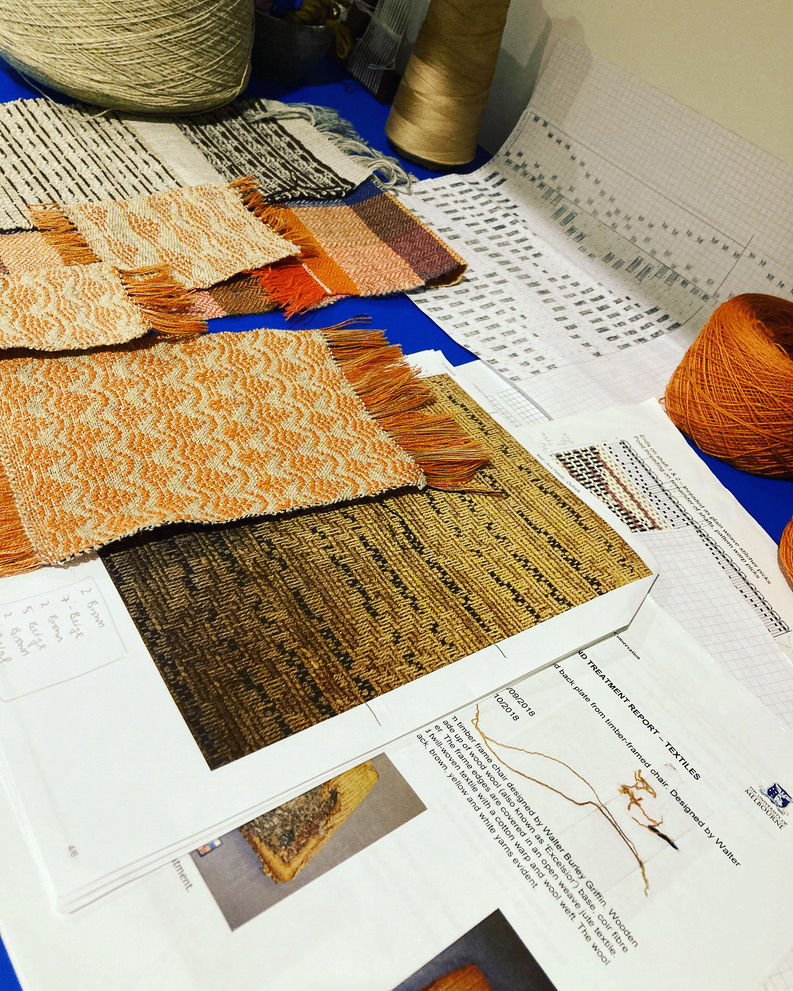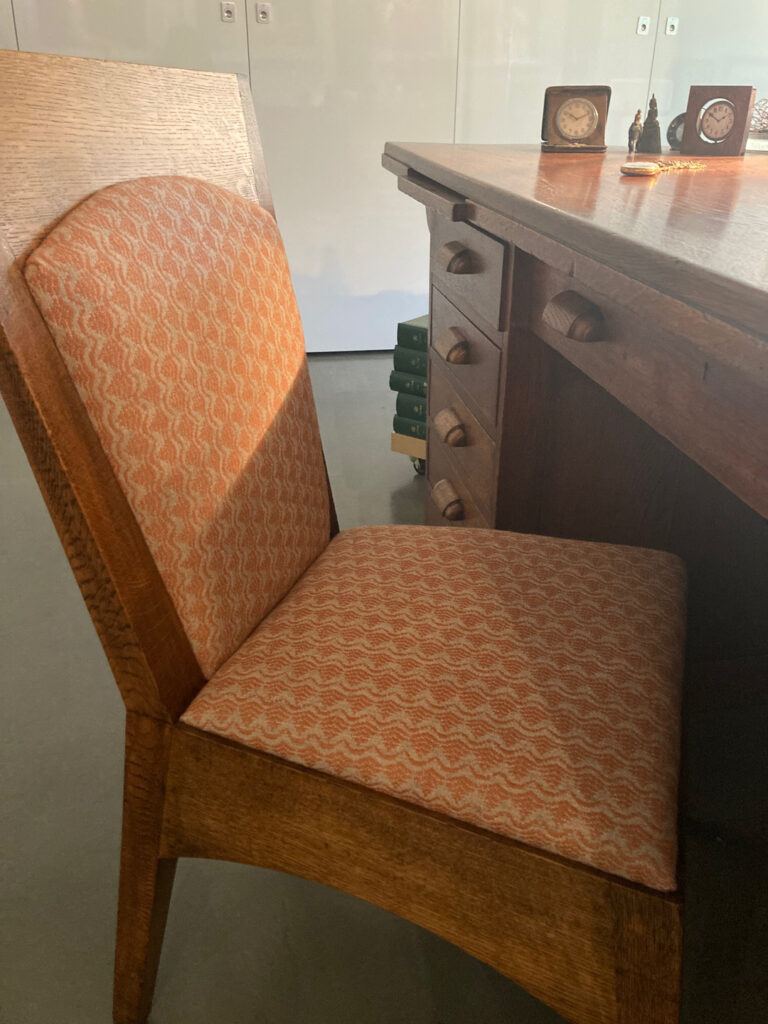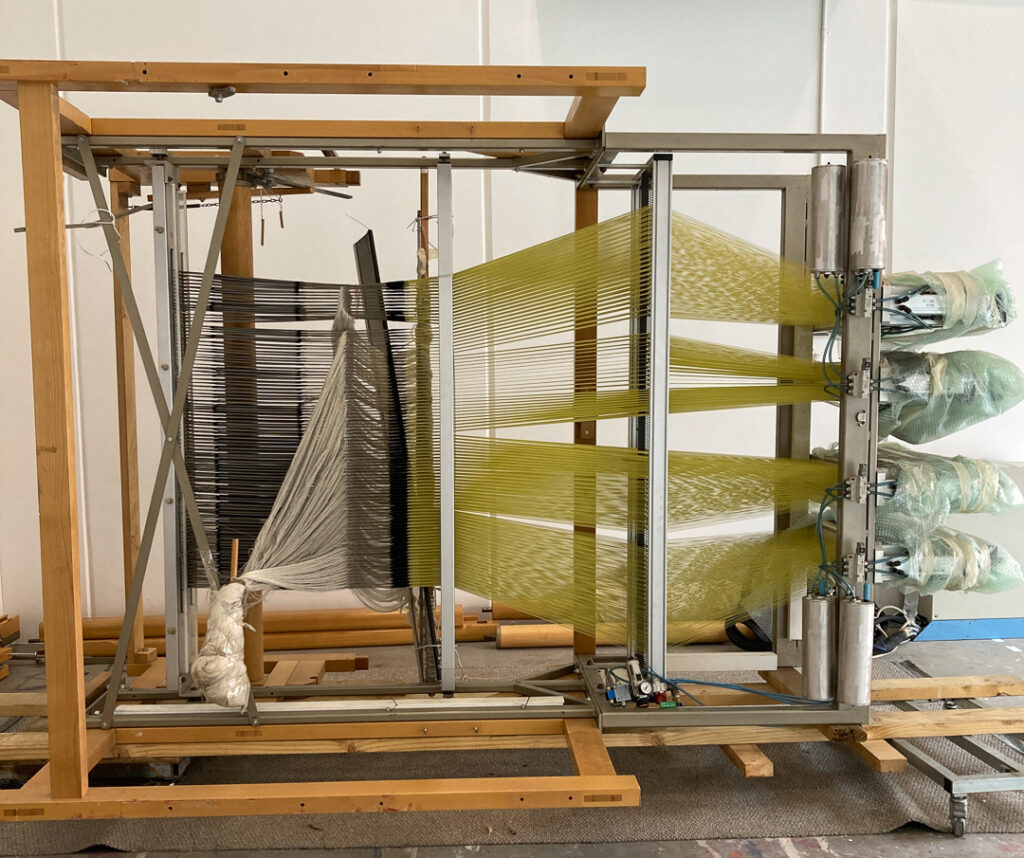Ana Petidis continues the collective spirit of the Handweavers and Spinners Guild
Growing up in a large Greek Australian family, inviting someone for “trapezi” (table) meant a sense of warm welcome and hospitality. “Elate yia trapezi” loses its meaning in English “Come to a table”. Trapezi also means come, I invite you to sit with us communally, whomever you are, sharing food, drink, stories and time. For me, what unfolds during time spent together is the growing connection and a sense of belonging. This connection and belonging has been a sustaining force of my part-time studio weave practice. I have been encouraged and invited to sit at numerous “tables”, spaces to create work, gather and share a common goal and project. I’m part of a diverse and vast constellation of textile artists, educators, students and collaborators who not only taught me about textile and fibre crafts but have provided me with numerous joyful opportunities.
Whilst it was short-lived (due to the insecurity of contract and casual employment terms I couldn’t sustain), I found meaningful work teaching design and weave at tertiary level and in the community. I also found work in the textiles industry designing woven fabrics at a mill. I’ve felt supported to apply for exhibitions, residencies and awards. I’ve collaborated to create exhibitions and events. I have been provided with mentoring and technical advice and offered the same. I have received commissions and a grant. This wouldn’t have been possible without a network that spans RMIT alumni (where I studied textile design), the Handweavers and Spinners Guild of Victoria, Tenfold Textile Collective and the broad creative community in my new hometown, nurtured by the Creative Ballarat team at council. I can only describe being connected and called upon by others in this community as personally rewarding and life-changing.

Introduction to Weave student samplers, 2023, Handweavers and Spinners Guild Victoria, photo Ana Petidis
In June 2023, I finished a complex and noteworthy commission. David, who has a passing interest in craft, had contacted the Handweavers and Spinners Guild. He was directed there by the Grimwade Centre, conservators of cultural materials at The University of Melbourne. They had treated his recently acquired historical chair for “an active pest infestation”. The chair was designed and owned by architect Walter Burley Griffin. The chair’s provenance dates to approximately 1918 and was housed in the home Walter and his partner Marion constructed and lived in at Heidelberg, Melbourne Pholiota.
The recommendation made by the conservators to David was to secure a new upholstery layer over the top of the original textile to protect its features and elements from further light and insect degradation. David spoke to a volunteer named Dorothy at the Guild who then contacted me to ask if I was interested in pursuing this project. I was definitely interested, daunted and delighted to have been contacted by the Guild who has members with decades more experience than myself. It was an honour for me to be invited to this table. I was suggested to Dorothy by other Guild members because of my known interest in researching historical textiles. They had attended a talk I gave at the end of my graduating year in 2017 which focused on a little-known Victorian hand weave studio, Eclarté, who during the 1940s to 60s operated a successful textile business.
- Ana Petidis, process image of WBG cloth on loom beam, 2023, photo Ana Petidis
- Ana Petidis, WBG Chair fabric fold, 2023, wool and silk, 208cm x 61cm, photo Ana Petidis
- Ana Petidis, process image of study and samples for WBG cloth, photo Ana Petidis.
- WBG Chair and Desk, 2024, photo Ana Petidis
I met David in August 2019 and discussed the possibility of handweaving a sympathetic upholstery fabric for his chair. I was eager to analyse the fabric, draft the pattern and try my best to recreate it. David was very trusting and regarded me as an expert in my field even before I showed him my box of samples that I had packed to show him as a resume of my work. He did not ask for a time frame to complete the project. At the end of the meeting, I walked away with the carefully wrapped chair panels and some trepidation about how I was going to achieve this goal.
Nearly four years later I completed and delivered the cloth to David. Interrupted by life and work responsibilities, the pandemic, a renovation and numerous doses of procrastination. But David was incredibly gracious and supportive despite my extended time frame. The Guild had not only facilitated access to this commission by means of introduction, but they also offered me mentoring through some of its members to discuss my study of the weave structure and yarns and see any directions I couldn’t. The resulting fabric was made with wool and silk, densely set to provide a protective shield. The pattern simulates the original scallop waves and fanned leaf design. Seeing the re-upholstered chair this year, I felt overwhelmed with relief and surprise at what I achieved.
At the other end of my table, and in contrast to an established entity like the Guild, I sit with another group of dedicated people who also weave. We don’t have a formal name; nor are we incorporated or under auspice. We came together through our want to save an important piece of equipment and technology, a computer-aided, hand-operated jacquard loom, the “ARM AG CH-3507 Loom”. It was purchased via a hefty grant approximately twenty years ago. In November 2022, we each learnt that the loom needed to find a new home urgently or it could end up in a scrap heap somewhere. A flurry of phone calls, emails, social media posts and Zoom meetings occurred and after an extraordinary effort by student alumni, acquaintances and strangers coming together, the loom was rescued. It was partially dismantled on campus in Brunswick, tipped on its side and wheeled out on a makeshift trolley onto a large trailer. It squeezed through a doorway into safety in a warehouse home in inner city Melbourne.
From there we documented our ideas for the loom’s future, our hopes and values. After research, grant writing, presentations and meetings; we pooled together time, energy, networks and resources to spread the word and seek support and solutions. We moved the loom again in July 2023 into a space we secured for two years through the generosity of Creative Ballarat. In November we used a small grant we had secured to hire a crane and steady the loom in its upright position; it towers three metres high and is almost three metres wide. Our actions now are focused on restoring it to its full operation.
I am so grateful for the connection and role the Guild and the loom rescue group provide. The Guild is a place heaving with knowledge, experience, skills, stories and more. It is a vital part of the landscape of cross-generational skill development, retention and innovation. The loom rescue group, a posse of individuals connected by our common goal, oddly belongs to the loom as we attempt to nurture it back to life.
Craft-based courses are dropping off formal tertiary programs in Australia and around the world. Student cohorts are smaller as the cost of living and education rises, and industry opportunities are scarce. In this context, collective actions such as the loom rescue and the Guild play an even more important role in connecting people to learning and practice opportunities. The Guild does this through an active volunteer and membership base, special interest groups, a library teeming with quality craft books and publications, established short courses, and an open door for curious beginners to renowned masters. Informal collectives also do this via their shared aspirations.
The Guild celebrates 70 years this year. Imagine the stories it can tell but more importantly the tacit skills and connections it continues to foster and share.
About Ana Petidis
 Ana Petidis is a Ballarat-based studio weaver who creates one-off cloth and tapestry works that communicate personal and shared stories through the considered joining of materials and processes. Grounded in her heritage and culture, Ana’s practice explores the connection to time and place through the entire process of weaving from fibre source to cloth creation. Follow @analog_cloth and @jacquardjournal.
Ana Petidis is a Ballarat-based studio weaver who creates one-off cloth and tapestry works that communicate personal and shared stories through the considered joining of materials and processes. Grounded in her heritage and culture, Ana’s practice explores the connection to time and place through the entire process of weaving from fibre source to cloth creation. Follow @analog_cloth and @jacquardjournal.








Comments
Love this story Ana, in addition to your skill they couldn’t have picked a more passionate person to weave that cloth and as I have said before, I think the loom is in better hands now than it was while languishing in the knit studio in Brunswick. Onwards and upwards 🙂